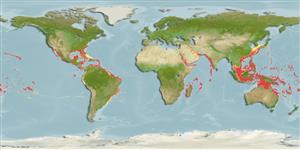Echinoidea |
Camarodonta |
Echinometridae
Environment: milieu / climate zone / تغييرات عمق / distribution range
بوم شناسي
; تغييرات عمق 0 - 139 m (مرجع 81020). Tropical
Indo-Pacific and Western Central Atlantic.
Length at first maturity / Size / Weight / سن
بلوغ: Lm ? range ? - ? cm Max length : 8.0 cm WD جنس نر / بدون خواص جنسي; (مرجع 800)
Found subtidally (Ref. 102838). Inhabits hard substrates by boring on rocks in shallow waters (Ref. 800). It is also found on fore-reefs (Ref. 87903). A grazing echinoid, predominantly scraping the substratum of turf algae (Ref. 125618). Feeds on algae (Also Ref. 129602) and small invertebrates. Associated with Athanas indica, which hides between its spines (Ref. 800). Associated with coral communities. Burrowing species (Ref. 129602).
Life cycle and mating behavior
بلوغ | تولید مثل | تخم ریزی | Eggs | Fecundity | Larvae
Members of the class Echinoidea are gonochoric. Fertilization is external. Brooding is common, eggs are held either on the peristome, around the periproct or deep into the concavities on the petaloids. Life cycle: Embryos develop into planktotrophic larvae (echinoplateus) and live for several months before they sink to the bottom using their tube feet to adhere on the ground where they metamorphose into young urchins.
مآخذ اصلی
مراجع | هماهنگ كننده | همكاران
Schoppe, S. 2000 A guide to common shallow water sea stars, brittle stars, sea urchins, sea cucumbers and feather stars (echinoderms) of the Philippines. Times Media Private Limited, Singapore. 144 p. (مرجع 800)
وضعيت در فهرست قرمز IUCN
(مرجع 130435: Version 2025-1)
وضعيت از نظر سايتس (مرجع 108899)
Not Evaluated
Not Evaluated
خطر برای انسان ها
استفاده انسانی
| FishSource |
ابزارها
اطلاعات بيشتر
Population dynamicsرشدMax. ages / sizesLength-weight rel.Length-length rel.نوسانات طولیMass conversionفراواني Life cycleتولید مثلبلوغFecundityتخم ریزیEggsنمو تخمLarvae Human RelatedStamps, coins, misc.
منابع اينترنتي
Estimates based on models
Preferred temperature
(Ref.
115969): 23.3 - 28.8, mean 27.1 (based on 1386 cells).
جهندگی
زياد, كمينه زمان لازم براي دو برابر شدن جمعيت ، كمتر از 15 ماه (K=0.4).
Fishing Vulnerability
Low to moderate vulnerability (29 of 100).
طبقه قيمت
Unknown.
